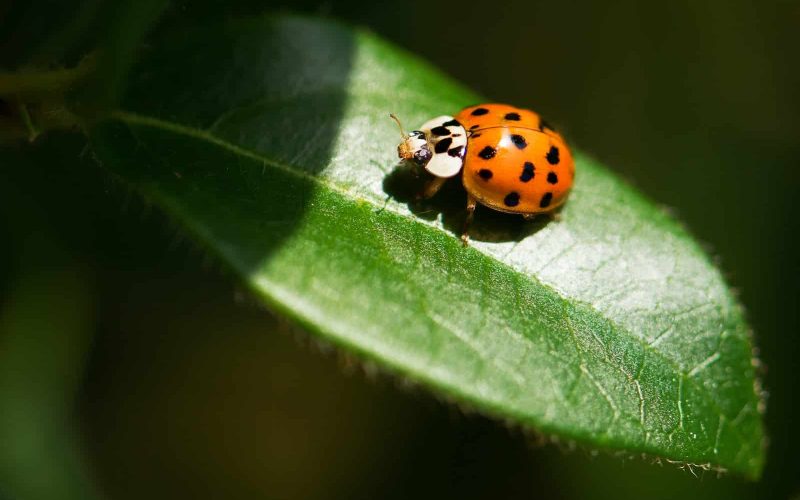Despite their usefulness in the garden, ladybugs do not make pleasant houseguests.
When faced with a ladybug infestation, use this helpful guide on how to get rid of ladybugs in the house.
It’s encouraging to see so many ladybugs thriving in the wild. They are beloved by gardeners for devouring pests like aphids and scales and by children of all ages for their brilliant patterns and spots.
However, an infestation may be impending if too many Coccinellidae exist, particularly if they have entered your home.
To survive the winter, the small beetles will often find their way inside people’s houses, where they may grow by the hundreds and become an overpowering nuisance.
Don’t let their adorableness fool you. These methods for getting rid of ladybugs in the house can help you reclaim your space.
What Does a Ladybug Look Like?
Most people can picture a typical ladybug: little, red, and round, with white markings on the head and black dots on the back.
While ladybugs are common, it’s essential to remember that there are more than 5,000 types worldwide.
Asian lady bugs, often called Harlequin ladybirds, are invasive and aggressive, threatening native ladybird populations worldwide.
Identifying these bothersome insects is made easier by a variety of distinguishing features. Determine the type of ladybug you’re up against before attempting to eradicate it.
Types of Ladybugs
Harlequin Ladybirds (Asian Lady Beetles)
These insects come in a wide variety of colors and patterns. Asian lady beetles may be seen in Various colors; some are pale yellow or tan, while others are bright orange or red.
Harlequin ladybirds may have anything from zero to several black patches on their backs. The white patch at the back of their heads often has a black “M” or “W” on it, making these pests easy to spot.
These bugs are more elongated and bigger than typical ladybugs seen in the wild. When challenged, they bite with their sharper-than-average lips and cheeks.
While these beetles eat nuisance pests, they do so in such vast numbers and with such an insatiable appetite that they threaten the native ladybug population’s ability to feed. Harlequin ladybugs are notorious for swarming into houses for warm shelter throughout the winter.
There have been cases when thousands invaded a home and spread all over the walls and flooring. It’s also worth noting that they produce a putrid-smelling, yellowish-brown liquid from their leg joints when they feel threatened.
When this secretion is let go within the body, it may lead to a foul odor and discoloration. The remains of Asian lady beetles might cause an allergic response in certain people if brought indoors.
Native Ladybirds
Typical colors for native ladybugs are red or orange. Little and spherical, with a black head and small white markings on the “cheeks,” this species is easily distinguished from its Asian counterpart.
Depending on the species, the spots on native ladybugs may range from precisely seven to nine. Since they feed on irritating and deadly garden pests, native ladybugs are safe and immensely helpful. Even when the temperature drops, native ladybugs don’t seek refuge inside.
How to Get Rid of Ladybugs in the House
Even while ladybugs aren’t dangerous to people or buildings, it’s best to keep them out of your house anyway.
Even if a colony of ladybugs has already been established, they may be eliminated by prevention, removal, or relocation. Here are the best strategies for getting rid of ladybugs in the house.
Turn on a Light Trap
Use a light trap to catch ladybugs infesting a dark space like an attic. You can buy one for about $35 or make your own using a plastic jug, a light bulb, and transparencies designed for overhead projectors. When you’re done with the ladybugs in your trap, let them free outside.
Use Diatomaceous Earth
Diatomaceous earth, a white powder widely available on the Internet or in hardware stores, can easily eliminate insects.
Sprinkle the powder around the perimeter of your colony or near any possible entry points to prevent further infestations and kill existing pests.
Use Duct Tape
Duct tape wrapped around a hand or finger may be used to pick up ladybugs that are out of reach. This will allow you to transfer the colony outdoors without endangering any inhabitants. Duct tape may also be left out as a simple trap.
Use a Vacuum Cleaner
Any lingering ladybugs may be sucked up by a vacuum cleaner and removed. Expiring ones left on window sills, hardwood floors, or carpets should be vacuumed to prevent flooring, walls, and upholstery damage.
Vacuuming live ladybugs allows you to quickly and easily release them outdoors. If you want to save the ladybugs, you may trap them in a handkerchief by placing it between the dust bag and the vacuum hose, then releasing them outdoors.
The vacuum’s suction will trap them, preventing them from flying away and settling in another part of your house.
Know that if you find a ladybug in your house, there’s a cause, and there’s something you can do to prevent them since there are several methods to get rid of ladybugs in the house.
Take action and fight a ladybug infestation professionally and in a homemade way. They will bring you a good fortune once you get them outside in the garden next spring.
Use Chemical Treatment
Chemical repellents and sprays should be used as a last option and in combination with other control methods in any pest control program. Chemical weapons should never be used first in defense or attack.
Overwintering ladybugs are extremely difficult to eliminate after the problem has been established indoors, making indoor treatments less than ideal. Vacuuming the bugs away is cleaner, less dangerous, and leaves fewer chemical residues in your home than other methods.
Taking preventative actions like closing access spots and vacuuming is considerably safer and more efficient.
Professional pest control services may execute an “overwintering insect treatment” around your house in the fall to prevent ladybugs and other pests from seeking shelter when winter comes.
The perimeter of the building is treated, including the foundation, door frames, and window frames.
Spray With Dish Soap
Dish soap is an easy approach to getting rid of ladybugs in the house if the infestation has gotten out of hand and it is too tough to transfer the colony.
If you see a colony gathering around a light, spray them with soapy water or put a dish there. The ladybugs can’t swim away from the soap because it is too thick.
How to Prevent Ladybug Infestations
As the weather cools in the autumn, ladybugs will seek warmer environments, and your home will be a prime target. They’ll squeeze through the smallest of openings. Use these preventative methods to ward off ladybugs.
Seal Gaps
Put silicone caulk around your home’s windows, doors, utility pipes, and any cracks or crevices in the outside walls. If your house is made of bricks, inspect the pointing and patch any fractures with mortar or cement to keep the ladybugs out.
Try Cloves or Bay Leaves
Cloves and bay leaves, in addition to being tasty and smelling wonderful, also serve as efficient insect repellents. You may keep ladybugs at bay during the planting season by planting these plants in your herb or container garden.
Use Natural Repellents
Oils like lavender, citrus, and citronella efficiently eliminate ladybug pheromones. Add a few drops of your natural cleaning solution to wipe down areas inside or outside your house where lady beetles have been discovered.
Surround Your Home With Mums
In addition to being a beautiful autumn flower, mums have long been used to keep bothersome insects at bay. Planting mums or other deterrent flowers outside your house or placing bulbs near doors and other entryways can help keep ladybugs at bay.
Winterize Your Home
Professional pest control services may spray outside your house to prevent pests from entering. It is important to have well-fitting screens on windows and doors with sufficient weather sealing. Seal any possible holes in the exterior of your house.
You won’t need to know how to get rid of ladybugs in the house if you prevent them from entering it.” When winterizing your house, ensure you handle any possible entrance points and seal gaps so none are visible. It’s better to do this before the temperature cools and ladybugs begin to make their way inside.
Conclusion
Ladybugs serve a useful purpose in the garden, but they become a nuisance once they enter the house.
Follow the steps outlined above on how to get rid of ladybugs in the house. Capture and release the insects, eliminate the pheromone trails they leave behind, and block any potential entry points.








